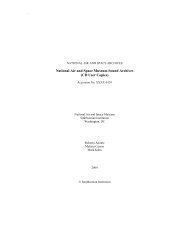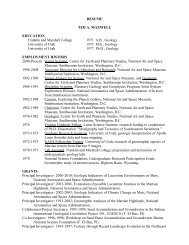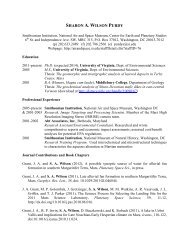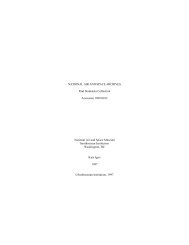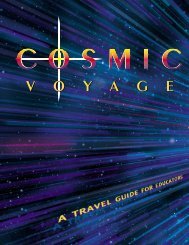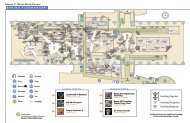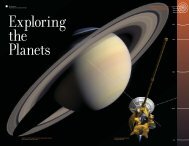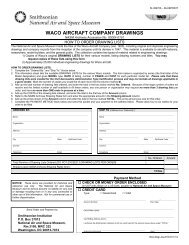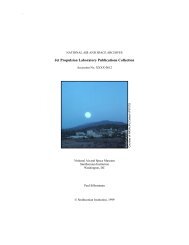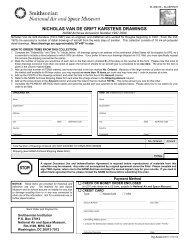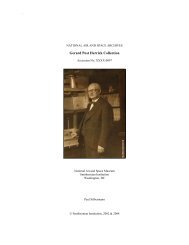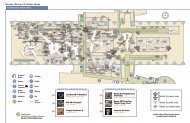NASM Poster Final PDFs - National Air and Space Museum ...
NASM Poster Final PDFs - National Air and Space Museum ...
NASM Poster Final PDFs - National Air and Space Museum ...
Create successful ePaper yourself
Turn your PDF publications into a flip-book with our unique Google optimized e-Paper software.
LIVING & WORKING IN SPACE<br />
exercising<br />
working<br />
sleeping<br />
preparing food<br />
washing hair
LIVING AND WORKING IN SPACE<br />
OVERVIEW<br />
This introduction to space exploration provides activities that increase students’ awareness of the<br />
environmental conditions of space, the challenges that must be overcome to live <strong>and</strong> work there, <strong>and</strong><br />
advances in spacesuit technology. Students consider various reasons for going to space <strong>and</strong> compare<br />
conditions in space with those on Earth. As a culminating activity, they analyze how a modern spacesuit<br />
enables astronauts to live <strong>and</strong> work under extremely hostile conditions.<br />
The poster is designed as a flexible teaching tool. The activity is written for fifth- through eighth-grade<br />
students who are studying space, but older students also can benefit from the activities <strong>and</strong> extensions.<br />
You are encouraged to visit the Smithsonian’s <strong>National</strong> <strong>Air</strong> <strong>and</strong> <strong>Space</strong> <strong>Museum</strong> in person or on the Web<br />
in order to give students the opportunity to see historic spaceflight artifacts. However, if you <strong>and</strong> your<br />
students are unable to visit the <strong>Museum</strong>, you can still use the poster <strong>and</strong> activity as a worthwhile part of<br />
your science program.<br />
Grade Level: 5 through 8<br />
Time Required: one to three class periods (50 minutes each)<br />
OBJECTIVES<br />
❚ List several major reasons why humans travel<br />
to space<br />
❚ Compare environmental conditions in space<br />
with those on Earth<br />
❚ Explain how spacesuits enable humans to<br />
survive in space<br />
EDUCATION<br />
STANDARDS<br />
ADDRESSED<br />
IN THIS ACTIVITY<br />
<strong>National</strong> Science Education St<strong>and</strong>ards<br />
Science <strong>and</strong> Technology<br />
Content St<strong>and</strong>ard E:<br />
As a result of activities in grades 5–8, all<br />
students should develop<br />
❚ Underst<strong>and</strong>ings about science <strong>and</strong><br />
technology
BACKGROUND INFORMATION FOR<br />
Only in the past four decades—after centuries of studying the Solar System from Earth—have humans<br />
developed the technology to travel to space <strong>and</strong> to experience <strong>and</strong> explore it firsth<strong>and</strong>. Humans have<br />
walked in space <strong>and</strong> on the Moon. We have launched giant telescopes into space <strong>and</strong> sent people<br />
there to service them. We are building a permanent space station 322 kilometers (200 miles) above<br />
the Earth. Today, people live <strong>and</strong> work in space for months at a time. But the everyday experience of<br />
living <strong>and</strong> working in space is very different from that on Earth.<br />
EARTH VS. SPACE<br />
Beyond Earth’s atmosphere, space becomes a hostile environment that cannot sustain human life.<br />
The following chart shows why by comparing environmental conditions on Earth with those in space.<br />
OXYGEN<br />
EARTH<br />
Our atmosphere contains sufficient oxygen to<br />
support human life.<br />
SPACE<br />
The level of oxygen is too low for humans; without<br />
protection, they would quickly perish.<br />
AIR<br />
PRESSURE<br />
Atmospheric gases push on our bodies from all<br />
directions. This pressure counterbalances the<br />
pressure of air <strong>and</strong> fluids pushing out from inside<br />
our bodies.<br />
<strong>Space</strong> is a vacuum with virtually no gases or air<br />
pressure. The air inside an unprotected human<br />
being’s lungs would exp<strong>and</strong>, leading to unconsciousness<br />
within 15 seconds.<br />
GRAVITY<br />
Gravity holds humans securely to the Earth.<br />
In the reduced gravity—or microgravity—of space,<br />
humans feel weightless. They are in a state of free<br />
fall—similar to the feeling of racing down from the<br />
top of a roller coaster.<br />
TEMPERATURE<br />
Atmospheric gases distribute heat from the Sun<br />
<strong>and</strong> balance global temperatures.<br />
With no protective atmosphere, the temperature of<br />
objects in space varies widely. Near the Earth <strong>and</strong><br />
Moon, it ranges from -156°C (-250°F) in the shade<br />
to 121°C (250°F) in sunlight.<br />
RADIATION<br />
The atmosphere filters out harmful radiation.<br />
With no protective atmosphere, electrically charged<br />
particles <strong>and</strong> high energy radiation from the Sun<br />
pose a major danger to humans.<br />
METEOROIDS<br />
The atmosphere slows down meteoroids <strong>and</strong><br />
disintegrates all but the largest.<br />
With no atmosphere to slow them down, meteoroids<br />
are a hazard. Even tiny ones (micrometeoroids)<br />
can easily penetrate a spacecraft, spacesuit, or<br />
human skin.<br />
FOOD AND<br />
WATER<br />
Both occur naturally <strong>and</strong> in abundance on Earth.<br />
There is no evidence of either in space.
TEACHERS<br />
SURVIVING IN SPACE<br />
INSIDE A SPACECRAFT<br />
While in space, humans must protect themselves<br />
against the extreme conditions described to the left,<br />
<strong>and</strong> they must bring with them everything they need<br />
to survive. <strong>Space</strong>craft like the <strong>Space</strong> Shuttle have a<br />
shell that provides protection from temperature<br />
extremes, solar radiation, <strong>and</strong> micrometeoroids.<br />
Inside the Shuttle, the air pressure <strong>and</strong> oxygen levels<br />
are controlled, just like on an airplane, <strong>and</strong> there are<br />
supplies of food <strong>and</strong> water. Astronauts wear regular<br />
clothes—including shorts <strong>and</strong> t-shirts. The only major<br />
environmental condition to which they must adapt<br />
is microgravity. Here are several ways astronauts<br />
meet the challenge of microgravity while inside<br />
the <strong>Space</strong> Shuttle:<br />
❚ Eating: Astronauts eat most food directly from<br />
sealed packages, not from open plates or bowls.<br />
Velcro attaches the packages to trays <strong>and</strong> keeps<br />
them from floating away. Silverware has magnets<br />
to keep it in place.<br />
❚ Sleeping: Astronauts spend the night in sleeping<br />
bags strapped to the wall so they don’t float around.<br />
❚ Bathing: Astronauts take sponge baths using wipes,<br />
or soap <strong>and</strong> wet cloths.<br />
❚ Working: <strong>Space</strong> tools are specially designed to attach to<br />
astronaut clothing <strong>and</strong> equipment with Velcro or cords.<br />
❚ Going to the bathroom: Special toilets with funnels <strong>and</strong><br />
suction ensure that what comes out goes down, not up.<br />
OUTSIDE A SPACECRAFT<br />
Today astronauts travel to space to service the Hubble<br />
<strong>Space</strong> Telescope (which orbits the Earth more than 480<br />
kilometers, or 300 miles, away) <strong>and</strong> to help assemble<br />
the International <strong>Space</strong> Station (located 322 kilometers,<br />
or 200 miles, above Earth). Both of these missions<br />
require astronauts to leave the shuttle <strong>and</strong> work in the<br />
vacuum of space. These spacewalks are called EVAs—<br />
or Extravehicular Activities. They require a spacesuit<br />
specifically designed for this purpose. With its protective<br />
layers enabling humans to survive in an otherwise<br />
hostile environment, a spacesuit is like a personal<br />
spacecraft. It provides everything needed for human<br />
survival for about eight hours. Without one, astronauts<br />
would quickly die.<br />
<strong>Space</strong>suits are complex devices. Technically known as<br />
Extravehicular Mobility Units (or EMUs), they are<br />
usually made up of 11 layers—each of which serves<br />
a different purpose. Here are some major features:<br />
❚ Maximum Absorption Garment (MAG): The first item<br />
astronauts put on is this adult-size diaper. When<br />
astronauts have to “go” when they’re outside in<br />
space, they can just “go” in their MAG.<br />
❚ Liquid Cooling <strong>and</strong> Ventilation Garment: This long<br />
underwear-like garment contains 91.5 meters (267<br />
feet) of plastic tubing. Cooling water circulates<br />
through the tubing to keep the astronaut at a<br />
comfortable temperature.<br />
❚ Pressure Bladder Layers: Two layers contain the<br />
spacesuit’s atmosphere <strong>and</strong> provide air pressure.<br />
The inner layer seals in the air. The outer layer<br />
prevents the suit from ballooning.<br />
❚ Thermal Micrometeoroid Layers: Nine layers of foil,<br />
mesh, <strong>and</strong> durable rip-stop cloth provide temperature<br />
insulation <strong>and</strong> protect against micrometeoroid<br />
penetration.<br />
❚ Life-Support System: This backpack contains oxygen,<br />
equipment to remove carbon dioxide, electrical<br />
power, <strong>and</strong> other life-support needs.<br />
❚ Helmet: The helmet itself is a clear bubble that<br />
encloses the astronaut’s supply of air. A visor covered<br />
with 14K gold reflects sunlight. Under the helmet,<br />
the astronaut wears a cap with earphones <strong>and</strong> a<br />
microphone.<br />
❚ Headlights: Located high on the astronaut’s backpack,<br />
they provide light during the dark half of<br />
every 90-minute orbit.<br />
❚ Gloves: These are the only component of modern<br />
spacesuits custom-made to fit each astronaut.<br />
❚ Boots: Since astronauts in orbit never set foot on<br />
l<strong>and</strong>, the boots don’t need treads.<br />
❚ Drink Bag: A water-filled plastic pouch—with a<br />
straw—is mounted inside the upper part of the suit.<br />
❚ Food: A high-nutrient food bar, with an edible rice<br />
paper cover, is located in the helmet—right near the<br />
mouth.<br />
❚ Tether: Attached to the spacecraft is a retractable cord,<br />
somewhat like a leash, that prevents the astronaut<br />
from floating away. (visible in poster image)
ABOUT THE POSTER<br />
The large image on the front shows Astronaut Rex<br />
J. Walheim during a 2002 extravehicular activity outside<br />
the International <strong>Space</strong> Station (ISS). It lasted<br />
6 hours <strong>and</strong> 20 minutes. He is wearing a toolkit <strong>and</strong><br />
the tether is visible. The United States is one of 16<br />
countries helping to build the ISS, located 322 kilometers<br />
(200 miles) above Earth. It has been continuously<br />
inhabited since November 2000. The completed<br />
station will be a laboratory where astronauts conduct<br />
research in microgravity <strong>and</strong> examine how the<br />
human body adapts to spaceflight. It may also serve as<br />
a training ground for longer missions <strong>and</strong> a stop for<br />
humans traveling to the Moon or Mars. The smaller<br />
images show daily activities inside the ISS or the<br />
Shuttle that carries astronauts there.<br />
❚ Exercising: A harness keeps astronaut Leroy Chiao<br />
in place as he runs on a treadmill (ISS, 2005).<br />
❚ Working: Russian cosmonaut Sergei K. Krikalev<br />
works with communications equipment (ISS, 2005).<br />
❚ Sleeping: Canadian payload specialist Bjarni V.<br />
Tryggvason sleeps without a pillow—allowing his<br />
head to float freely in microgravity (<strong>Space</strong><br />
Shuttle, 1997).<br />
❚ Preparing Food: Astronaut Richard Searfoss uses<br />
Velcro to attach food packets to trays (<strong>Space</strong><br />
Shuttle, 1998).<br />
❚ Washing Hair: Microgravity causes Astronaut<br />
S<strong>and</strong>ra H. Magnus’s hair to st<strong>and</strong> on end during<br />
a shampoo (<strong>Space</strong> Shuttle, 2002).<br />
VOCABULARY<br />
air pressure<br />
atmosphere<br />
Extravehicular Activity (EVA)<br />
Extravehicular Mobility Unit (EMU)<br />
gravity<br />
International <strong>Space</strong> Station (ISS)<br />
meteoroid<br />
microgravity<br />
micrometeoroid<br />
radiation<br />
<strong>Space</strong> Shuttle<br />
spacecraft<br />
spacewalk<br />
1<br />
COMPLETED INTERNATIONAL SPACE STATION (ISS)<br />
MATERIALS<br />
For each team of students:<br />
❚ one copy of each Blackline Master<br />
❚ pencils<br />
For the class:<br />
❚ poster<br />
MATERIALS FOR<br />
MUSEUM VISIT (OPTIONAL)<br />
For each student:<br />
❚ “Exploring <strong>Space</strong>” self-guide<br />
PREPARATION<br />
Copy the two Blackline Masters for each team of<br />
students. A few days before beginning the activity,<br />
display the poster <strong>and</strong> encourage students to take<br />
a close look at it.<br />
PROCEDURE<br />
Ask students to think about why humans choose to<br />
live <strong>and</strong> work in space. Going to space is risky <strong>and</strong><br />
expensive. It’s safer <strong>and</strong> cheaper to study space from<br />
right here on Earth—through powerful telescopes,<br />
for example—or to send robot explorers. Why go?
Have students work in small groups. Tell each group<br />
to come up with at least three reasons why humans<br />
would want to live <strong>and</strong> work orbiting Earth or in far<br />
space—e.g., the Moon <strong>and</strong> beyond. Encourage<br />
them to be thoughtful <strong>and</strong> to go beyond the obvious<br />
answers by considering questions such as these:<br />
❚ Why would humans choose to spend up to six<br />
months in space?<br />
❚ Why are we building a permanent station in space?<br />
❚ What can we do in space that we can’t do here?<br />
❚ Why do astronauts take animals <strong>and</strong> plants to space?<br />
Then have each group share their thoughts with the<br />
whole class. Here are some reasons to bring up if<br />
students don’t think of them:<br />
❚ To learn how space travel affects the human body<br />
❚ To find out more about the effects of microgravity<br />
❚ To study science in ways that aren’t possible on Earth<br />
❚ To increase our knowledge of other planets <strong>and</strong><br />
the universe<br />
❚ To put <strong>and</strong> maintain telescopes <strong>and</strong> other<br />
scientific equipment in space<br />
❚ To get closer to other planetary bodies <strong>and</strong> see<br />
them close-up, without the distorting effects of<br />
Earth’s atmosphere (e.g., clouds, air turbulence,<br />
city lights)<br />
❚ To collect samples of soil <strong>and</strong> rock from other<br />
planetary bodies<br />
❚ To find out if life exists on other planets<br />
❚ To satisfy our curiosity<br />
You may want to conclude by asking students: Are<br />
there any reasons why you think humans should not<br />
live <strong>and</strong> work in space? Some possible responses are:<br />
❚ It’s dangerous.<br />
❚ It’s expensive. There are others ways to spend the<br />
money.<br />
❚ Astronauts might bring back alien organisms that<br />
could harm life on Earth.<br />
In discussing these issues, it may be helpful to<br />
explain that while space travel is expensive, it<br />
receives less than 1% of the national budget.<br />
Robotic travel would be cheaper, but robots can’t<br />
do everything humans can do.<br />
2<br />
3<br />
4<br />
Help students underst<strong>and</strong> the challenges of living<br />
<strong>and</strong> working in space by having them compare<br />
conditions on Earth with those in space. Have<br />
students break up into small groups, <strong>and</strong> give each<br />
group a copy of Blackline Master #1. Ask the groups<br />
to discuss each environmental condition listed in<br />
the left-h<strong>and</strong> column <strong>and</strong> then fill in the two<br />
columns on the right, based on what they already<br />
know about Earth <strong>and</strong> space. Tell students that they<br />
may not be able to fill in all the blanks equally well.<br />
Encourage them to just do the best they can by<br />
sharing what everyone in the group knows.<br />
When the students finish, discuss the responses with<br />
the entire class, <strong>and</strong> record the answers on the<br />
board. Ask students how they feel about the concept<br />
of living <strong>and</strong> working in space. Do the challenges<br />
seem insurmountable? Can students imagine some<br />
ways to meet the challenges? Which challenge seems<br />
the greatest?<br />
Direct students’ attention to the images on the<br />
front of the poster. Ask students what’s happening<br />
in each of the small images. What’s different about<br />
performing these activities in space rather than on<br />
Earth? Emphasize that in all the images the astronauts<br />
are coping with the effects of microgravity.<br />
Use the information provided in the background<br />
information section to discuss how this challenge is<br />
met in each activity.<br />
Then ask students why the astronauts are not wearing<br />
spacesuits. Are they surprised to see astronauts<br />
in regular clothes? Explain how spacecraft provide<br />
oxygen <strong>and</strong> air pressure <strong>and</strong> protect against temperature<br />
extremes, radiation, <strong>and</strong> micrometeoroids. As<br />
long as astronauts stay inside the spacecraft, they do<br />
not have to wear a spacesuit.<br />
Now have students focus on the large image of the<br />
astronaut working on the International <strong>Space</strong><br />
Station. What is he doing? Explain what the<br />
International <strong>Space</strong> Station (ISS) is <strong>and</strong> how astronauts<br />
may spend up to 8 hours at a time outside in<br />
space building <strong>and</strong> repairing it. Ask students how<br />
they think the astronaut is able to survive under<br />
these conditions for such a long time. The spacesuit<br />
is the key. Emphasize that it is worn only outside the<br />
spacecraft, <strong>and</strong> that it must provide everything<br />
needed for human life. Without it, the astronaut<br />
would die.
EXTENSIONS<br />
5<br />
6<br />
Tell students that they are now going to discover<br />
some of the major ways in which a spacesuit enables<br />
astronauts to survive outside the spacecraft for<br />
hours at a time. Have students work in small<br />
groups, <strong>and</strong> give each group a copy of Blackline<br />
Master #2. Tell students to compare the spacesuit<br />
drawing with the large poster image as they discuss<br />
each of the spacesuit’s labeled features. Challenge<br />
them to fill in the three missing labels using the<br />
words at the top left of the Blackline Master.<br />
These are the:<br />
❚ Headlights (located on both sides of the helmet)<br />
❚ Liquid Cooling <strong>and</strong> Ventilation Garment (visible<br />
through a cutaway on the spacesuit leg)<br />
❚ Life-Support System (the large backpack)<br />
When students finish, have the groups share their<br />
answers with the whole class. Then remind students<br />
of the conditions in space that they discussed in<br />
step #2 above. Ask students how the spacesuit<br />
protects astronauts against each of these conditions:<br />
❚ Lack of oxygen (oxygen inside backpack)<br />
❚ Lack of air pressure (pressure layers)<br />
❚ Microgravity (tether to spacecraft)<br />
❚ Extreme temperatures (insulating layers)<br />
❚ Radiation (helmet <strong>and</strong> gold-plated visor)<br />
❚ Meteoroids (protective layers)<br />
❚ No food or water (food <strong>and</strong> water supplies inside<br />
spacesuit)<br />
You might end the activity by sharing with students<br />
some basic information about the spacesuit.<br />
Ask students:<br />
❚ How much do you think it weighs? (nothing in<br />
space because of microgravity; 112 kilograms, or<br />
295 pounds, on Earth)<br />
❚ How long do you think it takes an astronaut to<br />
put on the suit? (2-3 hours, mainly because of the<br />
breathing exercises that help astronauts adjust to<br />
the pure oxygen atmosphere inside the suit)<br />
❚ How long do you think it takes to make a suit?<br />
(about 5,000 hours)<br />
1<br />
2<br />
3<br />
4<br />
Take students on a field trip to the <strong>National</strong> <strong>Air</strong> <strong>and</strong><br />
<strong>Space</strong> <strong>Museum</strong> in Washington, D.C., to see a replica<br />
of the <strong>Space</strong> Shuttle spacesuit as well as models of<br />
the <strong>Space</strong> Shuttle <strong>and</strong> International <strong>Space</strong> Station.<br />
You may also want to visit the display of spacesuits<br />
from earlier space programs. You can download a<br />
student self-guide to six historic craft (including the<br />
<strong>Space</strong> Shuttle) that carried humans in space:<br />
“Exploring <strong>Space</strong>.” Visit the <strong>Museum</strong>’s web site at<br />
http://www.nasm.si.edu/education/resources_guides.cfm.<br />
Take students on a field trip to the Udvar-Hazy<br />
Center in Chantilly, VA, to see the <strong>Space</strong> Shuttle<br />
Enterprise <strong>and</strong> a quarantine facility for astronauts<br />
who returned to Earth from the Moon. You can<br />
download a student self-guide to these <strong>and</strong> some of<br />
the other highlights there: “What’s Tops at the<br />
Udvar-Hazy Center.” Visit the <strong>Museum</strong>’s web site at<br />
http://www.nasm.si.edu/education/resources_guides.cfm.<br />
Have students work in teams to design a spacesuit<br />
that would enable humans to live <strong>and</strong> work on Mars.<br />
Ask them to research the environmental conditions<br />
on Mars: oxygen, air pressure, gravity, temperature,<br />
radiation, <strong>and</strong> presence of food <strong>and</strong> water. Tell them<br />
that the person who wears their spacesuit will be<br />
exploring the surface of Mars. The spacesuit must<br />
protect the person from the Martian environment,<br />
be comfortable enough to wear for up to eight<br />
hours, <strong>and</strong> enable the person to bend <strong>and</strong> reach for<br />
rock <strong>and</strong> soil samples <strong>and</strong> to use tools <strong>and</strong> other<br />
equipment. Ask students to draw <strong>and</strong> label their<br />
final spacesuit design, noting what features enable<br />
the person inside to survive <strong>and</strong> carry out work.<br />
Assign students to do research on the other planets<br />
to find out about the conditions there. What would<br />
humans need to survive on each planet? Are there<br />
any planets that would be impossible for humans<br />
to visit?
EARTH VS. SPACE CHART<br />
BLACKLINE MASTER #1<br />
EARTH<br />
SPACE<br />
OXYGEN<br />
AIR<br />
PRESSURE<br />
GRAVITY<br />
TEMPERATURE<br />
RADIATION<br />
METEOROIDS<br />
FOOD AND<br />
WATER
SPACE SHUTTLE SPACESUIT<br />
BLACKLINE MASTER #2<br />
LABEL THESE PARTS:<br />
❚ Headlights (2 places)<br />
❚ Liquid Cooling <strong>and</strong> Ventilation Garment<br />
❚ Life-Support System<br />
TV Camera<br />
TV Camera<br />
Helmet with<br />
14K gold visor<br />
Food bar<br />
inside helmet<br />
Drink bag with<br />
up to 32 oz.<br />
of water<br />
Temperature<br />
Control Valve<br />
Custom-made<br />
gloves with<br />
fingertip heaters<br />
Boots with no treads<br />
Maximum Absorbency Garment
RESOURCES FOR TEACHERS<br />
BOOKS:<br />
Butterfield, Moira. Look Inside Cross-Sections: <strong>Space</strong>. London: Dorling-Kindersley Press, 1994.<br />
Joels, Kerry Mark. The <strong>Space</strong> Shuttle Operator’s Manual. NY: Ballantine Books, 1988.<br />
Kozloski, Lillian D. U.S. <strong>Space</strong> Gear: Outfitting the Astronaut. Washington, D.C.: Smithsonian Institution<br />
Press, 1994.<br />
Vogt, Gregory L. The <strong>Space</strong> Shuttle. NY: Franklin Watts, 1983.<br />
Vogt, Gregory L. Suited for <strong>Space</strong>walking. Houston, TX: NASA Johnson <strong>Space</strong> Center, 1998.<br />
WEB SITES:<br />
For more information on space, spacecraft, <strong>and</strong> spacesuits, visit the Web site of the <strong>National</strong> <strong>Air</strong> <strong>and</strong> <strong>Space</strong><br />
<strong>Museum</strong> at http://www.nasm.si.edu. Navigate to “Exhibitions” <strong>and</strong> then to the following galleries: Milestones of<br />
Flight, <strong>Space</strong> Race, Rocketry <strong>and</strong> <strong>Space</strong> Flight, Exploring the Planets, <strong>and</strong> Apollo to the Moon.<br />
For more information on the evolution of the space suit, visit<br />
http://quest.nasa.gov/space/teachers/suited or http://history.nasa.gov/spacesuits.pdf<br />
For more information on space food, visit<br />
http://spaceflight1.nasa.gov/spacenews/factsheets/pdfs/food.pdf<br />
OTHER NATIONAL AIR AND SPACE MUSEUM TEACHING POSTERS:<br />
Exploring the Planets<br />
Destiny in <strong>Space</strong><br />
VISITING THE NATIONAL AIR AND SPACE MUSEUM<br />
The Smithsonian <strong>National</strong> <strong>Air</strong> <strong>and</strong> <strong>Space</strong> <strong>Museum</strong> <strong>and</strong><br />
its companion facility, the Steven F. Udvar-Hazy Center<br />
in Virginia, maintain the largest collection of historic<br />
aircraft <strong>and</strong> spacecraft in the world. Both buildings are<br />
open from 10:00 a.m. to 5:30 p.m. daily.<br />
A full schedule of guided tours <strong>and</strong> daily programs for<br />
school groups is available on the <strong>Museum</strong>’s Web site<br />
http://www.nasm.si.edu/. Advance registration is<br />
required. For more information on school programs<br />
or to schedule a “Living <strong>and</strong> Working in <strong>Space</strong>” tour at<br />
the <strong>National</strong> Mall building, visit the Web site.<br />
Copyright ©2006 by the <strong>National</strong> <strong>Air</strong> <strong>and</strong> <strong>Space</strong><br />
<strong>Museum</strong>, Smithsonian Institution<br />
Photos courtesy of the <strong>National</strong> Aeronautics <strong>and</strong><br />
<strong>Space</strong> Administration (NASA)<br />
<strong>National</strong> <strong>Air</strong> <strong>and</strong> <strong>Space</strong> <strong>Museum</strong><br />
7th <strong>and</strong> Independence Ave., SW<br />
Washington, DC 20560



